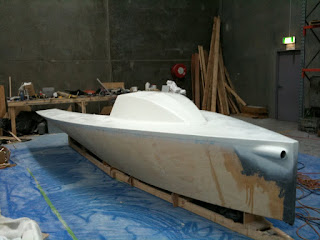
Well there she is folks - the great White Whale, not a Clownfish at all, that's where the Theory Of Relativity comes in - boats expand in size by a factor of at least Four when the time comes to sand, fair and paint them. In addition, each minor blemish stands out like, well like, choose your favourite simile.
So anyway, back to the confessional. Fairing the boat is where you pay big time and money for your youthful exuberance and lack of attention to detail in the very beginning when you built your construction cradle, cut your frames, bottom and sides, joined everything together with cable ties and started slapping on the epoxy. The main truth we learned is this: Every time in the beginning when you saw something that didn't quite line up, or wasn't exactly fair and smooth, and you said to yourself "Oh that's no problem we can fair that", you were making a mistake.
The truth is that getting it right in the beginning is much, much, easier and quicker than trying to rectify a ripple in plywood, glass and epoxy with a long board. We've done it now, and the hull looks pretty fair, flat, square, parallel, smooth, whatever, and should, we hope, look good when Robert Hicks sprays the topcoat for us. Now back to specifics.
Firstly make sure your ply is cut exactly right. Ours was as far as we can tell. There was a minor error in the plans that was detected and corrected by Tim before we got too far.
As for the building cradle, we had those Eight offsets and built a cradle with Seven supports that matched the hull profile in way of the frames as far as we could tell. I suspect that this was a mistake, and if I was doing it again, I would probably just use Three Supports, 169.5, 110 and 36, that way I should be able to see a good continuous curve on the chines.
As for joining the ply to make the bottom and sides, our joints were all too stiff, so we got a flat spot at each join that had to be filled and faired.
As for fitting the frames, we got the bottoms to fit very nicely no problems, but we couldn't get fair curves with the frames pulled in to the sides. I'm still not quite sure what was going on there. Be aware that not getting it all to fit exactly is going to give you problems at your shear line when the deck goes on, requiring a little creative freehand planing, but hey it's your project and the hull still measures OK anyway. I suspect that part of the problem was caused by the aforementioned not supporting the boat on three points. Maybe if I had, everything would have adjusted itself a little when we fitted the frames. This is something older and wiser heads can ponder.
But anyway, back to the sanding and fairing. We followed Robert Hicks advice. He is a professional yacht designer and builder, and he has built our bulb, keel and rudders for us. The recipe he gave us was as follows..
After glassing, go over the hull with a batten and fair any obvious hollows and bumps with your West system stuff. The next step is to screed the entire hull in a thin coat of West System fairing compound. I used a plasterers trowel for that. The next step is to get out the long board with 40 grit on it. Because we had relatively flat panels and frames spaced about Four feet apart at the back, I made a Twelve foot (2.4m) Two person longboard for the bottom and chines. You only need a Three foot flexible one for the sides.
Get yourself a can of spray paint in a suitably visible colour and liberally spatter dots of it over your hull. Apply the long board....After about half an hour the remaining paint will show you the low spots. If they are relatively small and shallow, fill them with "builders bog" (quick setting polyester) stop for lunch, apply a little more spray paint indicator and continue sanding with the long board. When you think you have it fair, apply your first coat of undercoat, then apply the long board, spray paint, filler and 80 grit to that. Repeat the whole process for Two weeks till you are sanding the final undercoat with 320 grit and everything is as smooth as it can get, or you just get too tired to care. Then apply topcoat.




















